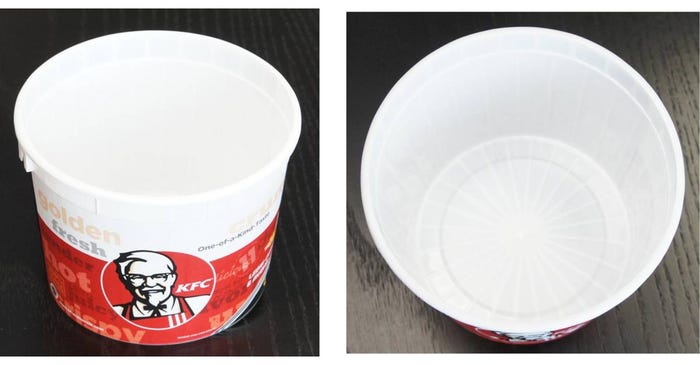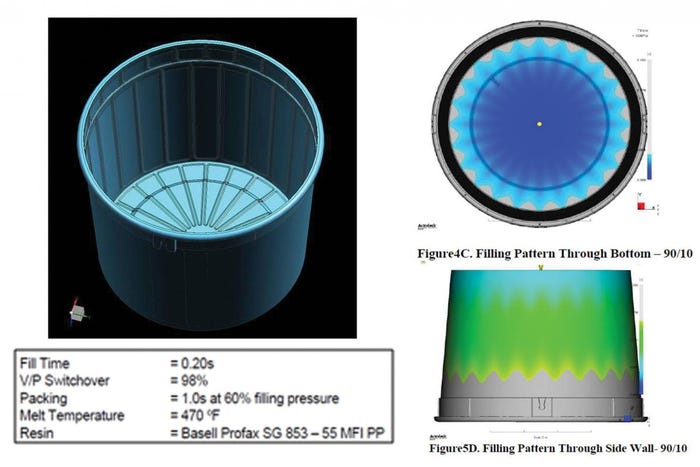StackTeck introduces first commercial application for its proprietary TRIM ultra-thinwall packaging
When it comes to in-mold labeling (IML) systems, StackTeck Systems Ltd. has many years of experience in developing this technology. StackTeck, a global manufacturer of multi-cavity, high-volume production molds for packaging, thin-wall packaging, closures, medical, and mold bases, has built 80 IML systems over the past few years. Not only does the company design and build the molds, but they have extended capabilities such as system integration (robotics and automation), and can perform system evaluations in house.
February 28, 2014
When it comes to in-mold labeling (IML) systems, StackTeck Systems Ltd. has many years of experience in developing this technology. StackTeck, a global manufacturer of multi-cavity, high-volume production molds for packaging, thin-wall packaging, closures, medical, and mold bases, has built 80 IML systems over the past few years. Not only does the company design and build the molds, but they have extended capabilities such as system integration (robotics and automation), and can perform system evaluations in house. The company will also train its customers of these complex systems how to set-up and operate them.
At the recent IMLCON (Feb. 20-21 in Phoenix, AZ), Jordan Robertson, StackTeck's general manager, business  development and marketing, introduced the company's first commercial application of the company's proprietary patent pending TRIM (Thin Recess Injection Molding) technology. The customer, SriThai Superware, challenged StackTeck to find a way to reduce the weight of an award winning part - a 64 oz. round pail used for popcorn at movie theaters, that was already at the limit of conventional thin-wall packaging, Robertson explained.
development and marketing, introduced the company's first commercial application of the company's proprietary patent pending TRIM (Thin Recess Injection Molding) technology. The customer, SriThai Superware, challenged StackTeck to find a way to reduce the weight of an award winning part - a 64 oz. round pail used for popcorn at movie theaters, that was already at the limit of conventional thin-wall packaging, Robertson explained.
"It has been demonstrated that conventional lightweight parts with L/T ratio up to 300, (length/thickness) can be made thinner with additional lightweighting of over 40% by weight," Robertson said. "By pushing the TRIM part design to the limit, covering approximately 90% of the part with ultra-thin panels, a weight savings of 41% was achieved. Most of the surface of this part has a wall thickness that corresponds to an L/T ratio of 550."
The original part was an award winner in the In-Mold Decorating Association's annual parts competition for Best Product Family.
Originally, TRIM was developed by StackTeck as an R&D project because the company needed a demonstration mold for their second generation IML pilot cell being installed. Stack-Teck has used that mold for demos at trade shows and machinery open houses ever since.
"It has taken a long time to get to this commercial application," Robertson said. "At first we had a small amount of bowing due to the fact that the thick areas acted like picture frames that squeezed the thinner areas."
All of the ribs are the original size, and StackTeck thinned out the top rim area to reduce weight. Other than the cores, which are new, StackTeck used the original mold and it runs in the same machine as the original 64 oz. pail, which saved SriThai the cost of having to build an entirely new mold. Since the product is cost sensitive, this was a huge advantage to the company.
Henry Rozema, StackTeck's VP of sales and marketing, said, "One of the powerful aspects of the TRIM technology is the ability to take the mold out of the press, swap out the core components, and then start making dramatically lighter parts in the same press as before. The ribs inside the container enable the part to fill just as easily as the original part did, in this case including a bale lug feature on the side of the rim where the bucket handle is attached.
"Our customer has been able to realize dramatic cost savings, with only a small investment in replacement parts," Rozema added. "We can now reach part weights at or below thermoformed parts, while continuing to offer special injection molded part features, such as tamper-resistant break tabs that add value to the package."

About the Author(s)
You May Also Like




